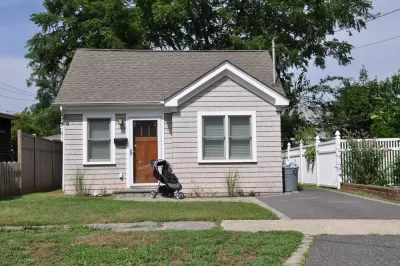Rising land costs, expensive materials, and onerous building and lot size requirements are making it harder to build small, affordable ‘starter homes’ in the United States.

For decades, the American Dream of homeownership rested on the concept of the ‘starter home:’ a simple, affordable, single-family house theoretically within financial reach of young people and families just starting out. But as Emily Badger writes in the New York Times, that path is increasingly closed off to most American households.
The nation has a deepening shortage of housing. But, more specifically, there isn’t enough of this housing: small, no-frills homes that would give a family new to the country or a young couple with student debt a foothold to build equity.
The rise in the cost of homes is due to a variety of factors, Badger continues. “Land costs have risen steeply in booming parts of the country. Construction materials and government fees have become more expensive. And communities nationwide are far more prescriptive today than decades ago about what housing should look like and how big it must be.” In some cases, requirements mandated by local ordinances raise the cost of construction.
Today, many builders say it’s becoming impossible to build small, low-cost homes on increasingly expensive land. Solutions include permitting the construction of more than one housing unit on a parcel and encouraging a variety of housing types such as townhomes, bungalows, and other ‘missing middle’ housing. “In the early 20th century, communities were effectively using all kinds of models to solve for affordable, entry-level housing. But the arrival of the car enabled people to move further out, and new planning ideas declared what would be built there.” With the midcentury suburban model growing more and more unsustainable, the future may well involve looking to the past.
FULL STORY: Whatever Happened to the Starter Home?

Alabama: Trump Terminates Settlements for Black Communities Harmed By Raw Sewage
Trump deemed the landmark civil rights agreement “illegal DEI and environmental justice policy.”

Study: Maui’s Plan to Convert Vacation Rentals to Long-Term Housing Could Cause Nearly $1 Billion Economic Loss
The plan would reduce visitor accommodation by 25% resulting in 1,900 jobs lost.

Planetizen Federal Action Tracker
A weekly monitor of how Trump’s orders and actions are impacting planners and planning in America.

Wind Energy on the Rise Despite Federal Policy Reversal
The Trump administration is revoking federal support for renewable energy, but demand for new projects continues unabated.

Passengers Flock to Caltrain After Electrification
The new electric trains are running faster and more reliably, leading to strong ridership growth on the Bay Area rail system.

Texas Churches Rally Behind ‘Yes in God’s Back Yard’ Legislation
Religious leaders want the state to reduce zoning regulations to streamline leasing church-owned land to housing developers.
Urban Design for Planners 1: Software Tools
This six-course series explores essential urban design concepts using open source software and equips planners with the tools they need to participate fully in the urban design process.
Planning for Universal Design
Learn the tools for implementing Universal Design in planning regulations.
Caltrans
Smith Gee Studio
Institute for Housing and Urban Development Studies (IHS)
City of Grandview
Harvard GSD Executive Education
Toledo-Lucas County Plan Commissions
Salt Lake City
NYU Wagner Graduate School of Public Service





























